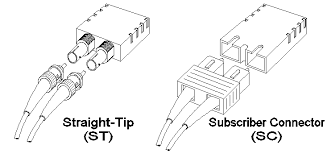
All about Straight Tip connectors
Design of ST Connectors
ST connectors consist of a cylindrical ferrule made of ceramic, plastic, or metal, which holds the fiber in place, and a spring-loaded bayonet mount that secures the connector to the equipment. The ferrule has a 2.5mm diameter, which is larger than the 1.25mm diameter of the ferrule used in other types of connectors, such as LC and SC connectors. The larger size of the ferrule makes it easier to handle and provides better alignment between the fibers.
The connector has a keying mechanism that ensures the proper orientation of the fibers during mating. The connector is inserted into the equipment and rotated until the bayonet mount clicks into place, indicating that the connector is securely attached. To remove the connector, the user must press a release tab on the connector and rotate it in the opposite direction.
ST Connector Types:
ST connectors come in a variety of configurations, including simplex, duplex, and multi-fiber ST connectors.
ST Connectors, Simplex: Simplex ST connectors contain a single ferrule and are used to connect two fibers or a piece of equipment. They are frequently used in applications that require only one fiber, such as single-mode or multimode patch cords.
Duplex ST Connectors: Duplex ST connectors are used to connect two fibers to each other or to a piece of equipment. They have two ferrules. They are frequently used in applications that need two fibers, such as fiber optic patch panels or switches.
Multi-Fiber ST Connectors: Multi-fiber ST connectors have multiple ferrules and are used to connect multiple fibers to each other or to a piece of equipment. They are commonly used in applications where multiple fibers are needed, such as in data center cabling or backbone networks.
Advantages of ST Connectors
ST connectors offer several advantages over other types of fiber optic connectors, including:
Durability: ST connectors are designed to be rugged and durable, making them suitable for use in harsh environments. They are made of high-quality materials that provide superior resistance to wear and tear, ensuring long-lasting performance.
Ease of Use: ST connectors are easy to install and remove, even in tight spaces. The bayonet mount ensures a secure and stable connection, while the release tab allows for easy removal without the need for special tools.
High Performance: ST connectors provide low insertion loss and high return loss, which means that they can transmit data over long distances with minimal signal loss. They are also compatible with both single-mode and multimode fibers, making them versatile and flexible.
Cost-effective: ST connectors are widely available and are relatively inexpensive compared to some other types of fiber optic connectors. This makes them a cost-effective option for many applications.
Standardization: ST connectors are standardized by the International Electrotechnical Commission (IEC) and are widely accepted as an industry standard. This means that they are compatible with a wide range of equipment and can be easily interchanged with other ST connectors.
ST connections are utilized in a variety of applications, including telecommunications, data centers, military and aerospace, and industrial applications. They can be utilized in a variety of cabling systems and are suited for both indoor and outdoor use.
Applications of ST Connectors
ST connectors are used in a wide range of applications, including:
Telecommunications: ST connectors are commonly used in telecommunications applications, such as in the construction of fiber optic networks and the installation of telephone lines. They are also used in cable TV and broadband internet applications.
Data Centers: ST connectors are widely used in data centers, where they are used to connect servers, switches, routers, and other network equipment. They are also used in storage area networks (SANs) and fiber channel networks.
Military and Aerospace: ST connectors are used in military and aerospace applications, where they must withstand harsh environmental conditions, such as extreme temperatures, high altitude, and vibrations. They are also used in military vehicles, aircraft, and ships.
988
0
746
172

